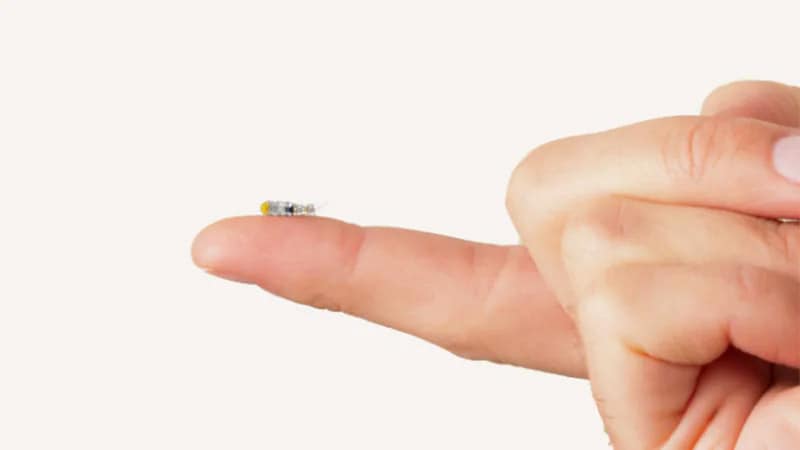US Supreme Court Grapples With Obamacare Preventive Care Case US Supreme Court Grapples With Obamacare Preventive Care Case
April 21, 2025Study Maps Sex-Specific Role of Testosterone on Knee OA Risk Study Maps Sex-Specific Role of Testosterone on Knee OA Risk
April 21, 2025
A French start-up, Robeauté, has raised €27 million ($29 million) to advance the development of its neurosurgical microrobot. This rice-sized device is designed to navigate the brain while avoiding high-risk areas. Its first clinical trial is planned for 2026, focusing on performing microbiopsies on brain tumors.
Precision Navigation
“The microrobot minimizes trauma and enhances precision during neurosurgery,” Arthur André, MD, neurosurgeon at the Hôpital Pitié-Salpêtrière, AP-HP, in Paris, France, who participated in the preclinical animal trials, told Medscape’s French edition.
While the robot’s primary evaluation will focus on cerebral oncology, specifically for performing biopsies, it is also being considered for other applications, such as administering targeted therapies locally and improving the placement of deep brain stimulation electrodes in the treatment of Parkinson’s disease.
Controlled Movement
Traditional neurosurgery relies on rigid tools, such as electrode holders or needles, which operate in straight lines. “We choose the least traumatic paths, but avoiding functional brain areas remains difficult,” said André, who specializes in minimally invasive procedures.
The risk of altering a patient’s motor or cognitive faculties with traditional interventions significantly limits the ability to operate with precision and can even prevent access to certain areas of the brain. In some cases, brain tumors are considered inoperable due to these constraints.
The microrobot is inserted into the brain through a small hole, just a few millimeters in diameter, made in the skull. It can navigate the brain’s extracellular matrix and vascular network along curved paths to reach the target sites. The silicone rings of the robot rotate at their tips, gently pushing aside tissues aided by adhesion forces at this scale. Real-time navigation is guided by imaging and ultrasound sensors placed on the skull of the patient.
Artificial Intelligence (AI)–Guided Path
The rings act like “a small helix that fractures without damaging cells, creating a path through the brain,” explained André. The microrobot moved smoothly at 3 mm/min and followed the same path when exiting.
Below the motor is a compartment that holds small instruments controlled by an external cable. A biopsy is performed using a flexible needle, and a small forceps grabs the tissue, which is either stored inside or pulled out through the cable.
Another unique feature of this microrobot is its trajectory to the target, which is preplanned using AI and MRI scans to avoid high-risk areas of the brain. Surgeons can adjust the movement of the robot in real time using an onboard ultrasound localization system. “The accuracy is within half a millimeter,” André noted.
This integration of imaging and ultrasound allows the robot to navigate in real time inside the brain and reach its target. For oncology biopsies, “we can sample from the tumor site and also study the behavior of cells in the peri-tumoral area,” particularly to assess the immune response and cancer progression.
Approval Expected by 2030
Preclinical trials, primarily conducted on sheep, have assessed the safety and efficiency of the device. These trials focused on ensuring that there were no side effects, particularly hematomas, after the use of microrobots. The results were promising enough to advance to clinical trials in humans.
To further develop the device, Robeauté plans to open a branch in the United States with the aim of obtaining approval from the US Food and Drug Administration and launching the device internationally by 2030. The first clinical trial, scheduled for early 2026, will be an international study involving the United States, Germany, and potentially France, through AP-HP, André noted.
“The trial will initially evaluate the robot’s ability to perform multisite biopsies in oncology. Future applications may include the use of the device to deliver targeted therapies directly to tumor sites, bypassing the blood-brain barrier. Brain oncology increasingly gives way to personalized treatments, such as targeted therapies or immunotherapies, based on the tumor’s biological profile. Beyond biopsies, the robot can deliver treatments directly to tumor sites,” explained André.
Parkinson’s Disease Potential
The applications of this robot extend beyond oncology. It may also play a role in treating neurodegenerative diseases such as Parkinson’s disease. In particular, it could help with the precise placement of electrodes for deep brain stimulation.
“With standard electrode implantation, it is sometimes difficult to find the exact sites to stimulate the subthalamic nucleus. The robot could make this process more efficient, advancing the standard of deep brain stimulation,” said André.
Unprecedented Access
In a press release, Bertrand Duplat, co-founder and CEO of Robeauté, stated, “There is unexplored potential for microrobots in medicine. Current neurosurgery techniques are invasive and can be fatal, and it is difficult for treatments to pass the blood-brain barrier and reach their intended target. We’re creating microrobots that will bring unparalleled access to the brain with personalized, precision medicine that can transform treatments and patient outcomes.”
Microrobots incorporate cutting-edge technologies, including a tiny engine, propeller, and steering system, enabling surgeons to track their movements in real time.
This story was translated from Medscape’s French edition using several editorial tools, including AI, as part of the process. Human editors reviewed this content before publication.
